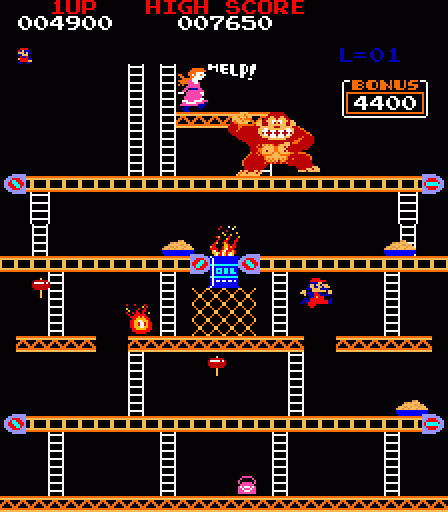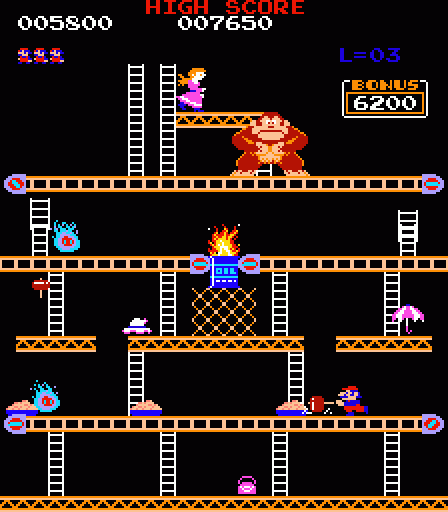Donkey Kong‘s second level has become something of a legend thanks to its omission in nearly every home port of the game ever released. See, Nintendo (and ghost-writer development house Ikegami Tsushinki) went a little crazy with the game’s design, cramming four different stage layouts into the arcade board. While these mostly shared assets amongst themselves, the second level apparently featured just enough unique graphics and mechanics that it couldn’t easily be squeezed into cartridges — even those released a few years after the arcade version’s debut. So, this level ended up being cut.
Why this stage, you ask? Probably because it is by far the weakest level of Donkey Kong.

After the clear, directed design of the first level, stage 2 lacks a certain clarity of purpose. Some of that is clearly intentional. The angled ramps vanish, removing the player’s straightforward path to the goal and replacing it with a more open symmetrical structure that allows you to climb up on either side.
Oddly, the hazards this time have nothing to do with Kong himself. He slides back and forth at the top of the screen, but he doesn’t throw anything. He’s just kind of there, pounding his chest at you to no avail. Instead, the threats come in the following forms:
- Fireballs disgorged from the OIL drum suspended above a wire mesh in the center of the screen. Like the first stage’s fireball, these drift slowly in Mario’s approximate direction with just enough unpredictability to be incredibly dangerous.
- Piles of wet cement in basins that slide steadily along the screen on two different levels. These can be leapt or destroyed with a hammer.
- The stage itself: The second, fourth, and fifth floors are conveyor belts. It’s not just Kong and the cement piles that roll along the belts. Mario does, too. Walking in the direction of a belt’s movement causes Mario to advance at double speed, while walking against its flow slows Mario’s pace to a crawl. Additionally, the ladders linking the fourth and fifth floors constantly rise and retract, forcing you to time you climb carefully lest you find yourself stranded midway up as a fireball chases you up the rungs.

That’s a lot of factors to keep track of in a level so much more freeform than the first. Realistically, this would make a better third stage than second. (Edit: And in fact, Nintendo seems to agree; in the U.S. version, this stage doesn’t even appear until your third loop through the game.) Since it lacks a clear focal point beyond “get to Pauline” while forcing you to deal with so many moving objects, it can be overwhelming for a first-time player. While the ultimate objective communicates itself fairly well by presenting itself identically to the goal of the first stage, even that’s a little fuzzy.
To beat this stage, you simply need to reach the fifth floor without climbing into Kong as he slides overhead. Unlike the previous level, you don’t actually need to ascend to Pauline’s level; as soon you hit Kong’s floor, he escapes to the next screen. It’s an odd inconsistency; I can understand why they didn’t design it so that you’re railroaded up the right side of the screen, but I don’t think it works nearly as well as the other stages.
Of all the stages to drop from home ports, I can see why they axed this one. Even so, it actually loosely inspired its own Game & Watch (Mario’s Cement Factory). I guess even substandard Donkey Kong ideas are still pretty OK.
Actually to most US players this was not the second board. Unless you were skilled you probrably never saw this board unless watching someone else. I know I could never get to it as a kid. Only on the Japanese Donkey was this the second stage. In the US you had to play quite a ways to even see the cement factory.
Japanese Donkey Kong:
1-2-3-4
1-2-3-4
1-2-3-4
1-2-3-4
USA Donkey Kong
1-4
1-3-4
1-2-3-4
1-2-3-4
Seeing that it does all four levels in order I take it the arcade Donkey Kong port in Donkey Kong 64 is based on the Japanese arcade version, then.
Of course, accessing classic Donkey Kong in Donkey Kong 64 requires stomaching the game’s collectathon nonsense up to the third world, but it’s the closest we’ve gotten to the original version of the game outside of that one limited edition shoddy NES ROMhack.
Okay, I knew I’d played or seen something somewhere that it had gone all loopy like that, but I never understood why.
Oh, so that’s how the USA version really works? I thought I had a busted ROM/emulator or something.
Remember how in “Game Over” by David Sheff, Donkey Kong was the first of many games that Howard Phillips championed for a North American release? I wonder if he decided on the changed structure as well.
Huh, I was wondering why every arcade unit of Donkey Kong I’ve ever played jumps to 100m after the first level.
Thanks for the reminder — I’ve been playing the Japanese version/Famicom hack I’d totally forgotten about this. I’ve updated the piece to reflect this fact.
Also, comments SHOULD be fixed now. I’ll leave them at two days and cross my fingers the spam doesn’t overwhelm me.
Also I think a lot of people didn’t realize that it was cement (and still don’t) and call it the pie factory level. I personally didn’t realize until the game and watch came out that it was cement and not pie.
Yeah, I think even the Mario Mania Player’s Guide called it the “pie factory,” though I think they used quotes, so they might have simply been referring to the fan name. Not like they went into a lot of detail.
For years, I figured “okay, they must be building a pie factory… I guess?”
What gets me is Nintendo’s refusal to release the original version of the game- the NES ROM hack was a welcome gesture, yet kind of weak at the same time.
See item 2: http://www.1up.com/do/feature?pager.offset=2&cId=3182436
I do remember that, yes, but as noted, they were able to use it in DK64. What’s more, they remade it in DK’94 as well. At the very least, if they can’t release the actual arcade ROM, it would be nice if they just remade it themselves instead of cheaply cobbling together something half-baked out of the NES ROM. I’m pretty sure they have the technology… faster, stronger, etc.
Ah yes. This stage did show up in the Commodore 64 port, which I played all the time as a kid. I definitely remember getting quite frustrated at this stage. I didn’t understand it at the time (I was 5, I think), but now that you point out the issues, it makes a lot of sense.
By the way, I always thought the wet cement was pie when I was a kid… 😛
It was in the version that ran on the Atari 800xl, too.
Could have sworn it went Level 1, Springs Everywhere, Cement Pie, Level 4 on that version.
Oddly, the VIC-20 and Atari XL/XE versions of Donkey Kong were among the few ports that had the cement factory stage. This was especially surprising on the VIC-20, which was a budget computer with only 3K of RAM to spare.
Anyway, speaking of pie factories…
http://www.youtube.com/watch?v=f9CqzBNxJ3k
There was a fifth stage planned for the Coleco ADAM version of Donkey Kong Jr., which never made it into the final release. It’s a battle in a kitchen, with Junior slipping under dough presses, riding on the top of an automated mixer, and dodging Mario’s deadly pies. What’s great is that you can actually feed Mario his just desserts, dropping fruit on him as he walks past.
Also, it’s not official, but damn is it good:
http://www.youtube.com/watch?v=yP4EOu1EWCI
It’s a hack of Donkey Kong with twice the stages, including some devious new ones. I’d definitely recommend giving it a shot!
That DKJr level is novel, but seems a little too simplistic. And I played DKII at PAX East last but found myself disappointed. Lots of cheap, untelegraphed deaths and levels that can only be completed with precise timing and memorization — it’s not bad, but it’s not very Nintendo-like.
Fair enough. I thought those levels were fairly well designed for a fan effort, but they are a bit too punishing and rigidly linear for Donkey Kong. In a standard DK level there are several tactics you can use to reach the big ape; with these new ones you’re forced to finish them exactly as the programmer intended.
I could see that kitchen level from the DKjr demo working with arcade-quality graphics and a little of Miyamoto’s elfin magic sprinkled on it.
One thing that Donkey Kong did, that carried over well into SMB, was the perfect balance between patient playing and frantic, careful jumping. It’s a measured pace that requires patience, but it’s not slow - you must always be making progress. This has always been the appeal of the Mario games to me. Nice article.
I wouldn’t expect a full Anatomy of a Game on it, but it would be neat to see something on how that tenet has (or has not) carried over the years to Super Mario Bros., Donkey Kong Country, and Donkey Kong Country Returns.
I agree, at least until reaching the third *loop*. Those who don’t know the trick will have a hell of a time getting by those springs at the top of Level 4 on their 3rd approach. A very cheap form of difficulty that was. Props to Steve Wiebe for disclosing the proper method, ala ‘King of King’.
‘King of Kong’, even.
What’s the official reason for Nintendo not being able to re-release the arcade version? I recall a Retronauts conversation where Jeremy mentioned that the arcade-board manufacturer (or some other party) stakes some type of ownership claim.
Look up Ikegami Tsushinki for more details, but in short, the pieced-together information stands as thus: Nintendo reportedly outsourced the programming of DK to a third party who converted Miyamoto’s design into numbers. DK was a huge hit. To meet demand, Nintendo produced far more boards than they had originally intended (something like 80,000 units). They also build off DK’s code base to create a sequel. Neither of these were done through I.T., who claimed some rights to the DK code and took Nintendo to court. Eventually the case was resolved outside of court, so no one knows the details of the settlement. But since then, Nintendo has only reissued the arcade game once (as a hidden bonus in DK64). So it stands to reason they either can’t use the arcade code, or else they preemptively don’t in order to avoid further conflict.
In Donkey Kong 94 they made this level too easy with the backflip.
True, the backflip makes things easier, but the level was also on a smaller scale to fit the Game Boy’s screen resolution.
Of course, there is a level late in the game that’s more on scale with the 25m we know and love.
Another point about the backflip: The first time most DK veterans played DK94, they never thought to try using SM64-style moves since (1) they weren’t in the original DK, which DK94 closely resembles at first, and (2) SM64 wasn’t out yet so no one would have thought, “I bet Mario can do a backflip!”
True indeed. Speaking of backflips, if you sit at the title screen of DK94 long enough, a demo video showing off Mario’s various acrobatics will play. It doesn’t tell you how to do any of them, but everything Mario shows off in the demo can be duplicated in-game.
For how few buttons are used, Mario is very versatile in Donkey Kong ’94 and Super Mario 64.